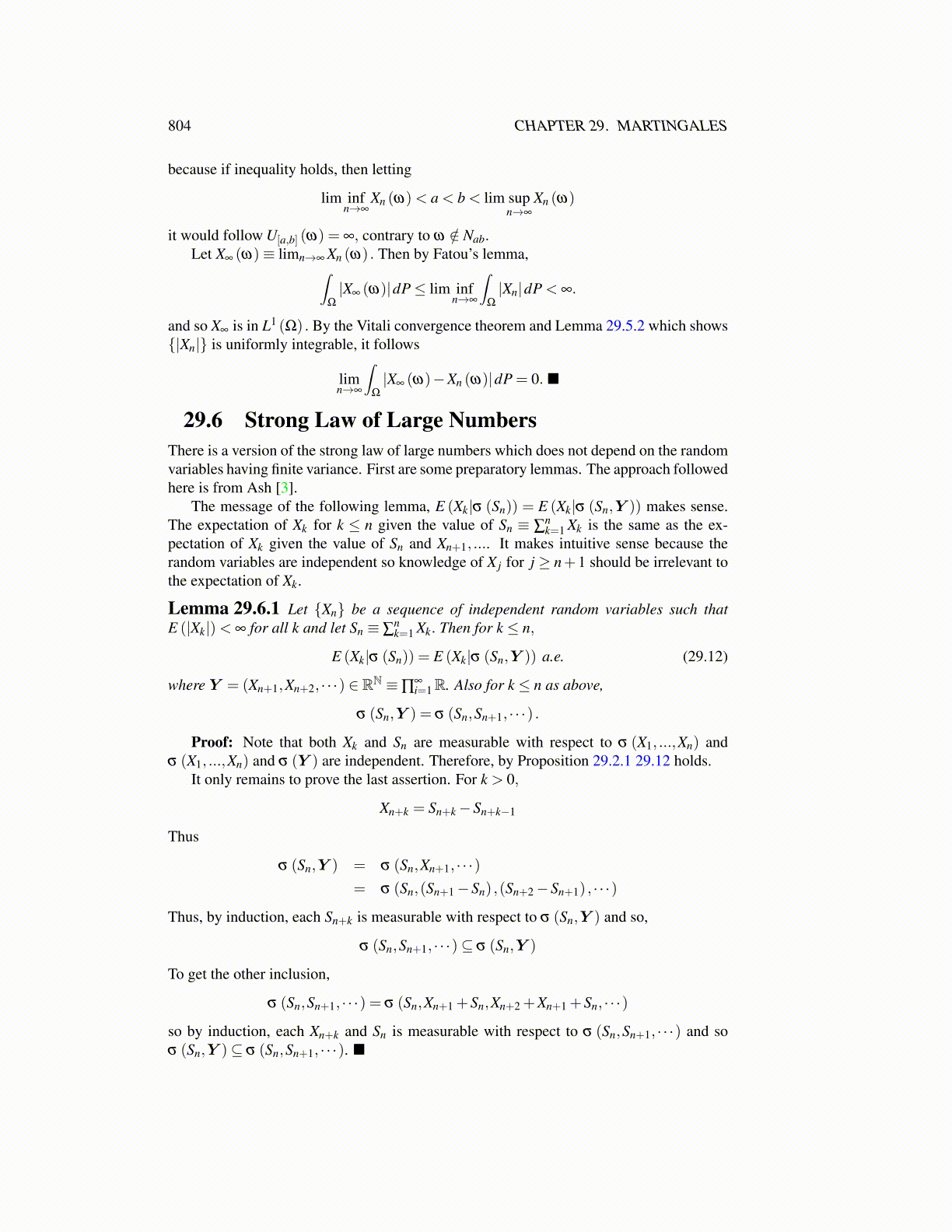
804 CHAPTER 29. MARTINGALES
because if inequality holds, then letting
lim infn→∞
Xn (ω)< a < b < lim supn→∞
Xn (ω)
it would follow U[a,b] (ω) = ∞, contrary to ω /∈ Nab.Let X∞ (ω)≡ limn→∞ Xn (ω) . Then by Fatou’s lemma,∫
Ω
|X∞ (ω)|dP≤ lim infn→∞
∫Ω
|Xn|dP < ∞.
and so X∞ is in L1 (Ω) . By the Vitali convergence theorem and Lemma 29.5.2 which shows{|Xn|} is uniformly integrable, it follows
limn→∞
∫Ω
|X∞ (ω)−Xn (ω)|dP = 0. ■
29.6 Strong Law of Large NumbersThere is a version of the strong law of large numbers which does not depend on the randomvariables having finite variance. First are some preparatory lemmas. The approach followedhere is from Ash [3].
The message of the following lemma, E (Xk|σ (Sn)) = E (Xk|σ (Sn,Y )) makes sense.The expectation of Xk for k ≤ n given the value of Sn ≡ ∑
nk=1 Xk is the same as the ex-
pectation of Xk given the value of Sn and Xn+1, .... It makes intuitive sense because therandom variables are independent so knowledge of X j for j ≥ n+1 should be irrelevant tothe expectation of Xk.
Lemma 29.6.1 Let {Xn} be a sequence of independent random variables such thatE (|Xk|)< ∞ for all k and let Sn ≡ ∑
nk=1 Xk. Then for k ≤ n,
E (Xk|σ (Sn)) = E (Xk|σ (Sn,Y )) a.e. (29.12)
where Y = (Xn+1,Xn+2, · · ·) ∈ RN ≡∏∞i=1R. Also for k ≤ n as above,
σ (Sn,Y ) = σ (Sn,Sn+1, · · ·) .
Proof: Note that both Xk and Sn are measurable with respect to σ (X1, ...,Xn) andσ (X1, ...,Xn) and σ (Y ) are independent. Therefore, by Proposition 29.2.1 29.12 holds.
It only remains to prove the last assertion. For k > 0,
Xn+k = Sn+k−Sn+k−1
Thus
σ (Sn,Y ) = σ (Sn,Xn+1, · · ·)= σ (Sn,(Sn+1−Sn) ,(Sn+2−Sn+1) , · · ·)
Thus, by induction, each Sn+k is measurable with respect to σ (Sn,Y ) and so,
σ (Sn,Sn+1, · · ·)⊆ σ (Sn,Y )
To get the other inclusion,
σ (Sn,Sn+1, · · ·) = σ (Sn,Xn+1 +Sn,Xn+2 +Xn+1 +Sn, · · ·)
so by induction, each Xn+k and Sn is measurable with respect to σ (Sn,Sn+1, · · ·) and soσ (Sn,Y )⊆ σ (Sn,Sn+1, · · ·). ■